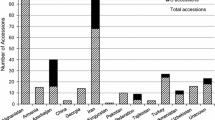Abstract
A collection comprising 157 Aegilops geniculata accessionsoriginating from different ecogeographical regions was established atENSA-INRA, Montpellier. The accessions were studied for physiologicaltraits related to drought and heat stress and screened for resistance tobarley yellow dwarf virus (BYDV) and rusts. Some accessions were alsotested for resistance to Hessian fly and cereal cyst nematodes (CCN). The study allowed to distinguish different adaptive strategies to theclimatic constraints encountered by Aegilops populations in theirregion of origin. They led to significant differences in biomass and grainproduction and should be taken into account in the utilisation of Ae.geniculata germplasm in wheat breeding programs. Two accessions withresistance to BYDV were found. Both originated from South of France. Theinterest of Ae. geniculata as a source of rust resistance was confirmedand accessions with resistance to the three rusts were identified. Highresistance against populations of Heterodera avenae and H.latipons was found in accessions from Spain, Bulgaria, Jordan and Tunisia.Sources of resistance to Hessian fly were also identified.
Similar content being viewed by others
References
Araus, J.L., A. Febrero & P. Vendrell, 1991. Epidermal conductance in different parts of durum wheat grown under Mediterranean conditions: the role of epicuticular waxes and stomata. Plant, Cell and Environment 14: 545–558.
Ayala, L., M. Khairallah, D. Gonzalez-de-Leon, M. van Ginkel, A. Mujeeb-Kazi, B. Keller & M. Henry, 2000. Identification and use of molecular markers to detect barley yellow dwarf virus resistance derived from Th. intermedium in bread wheat. Manuscript in preparation.
Barrs, H.D. & P.E. Weatherley, 1962. A re-examination of the relative turgidity technique for estimating water deficits in leaves. Australian Journal of Biological Sciences 15: 413–428.
Bekal, S., J. Jahier & R. Rivoal, 1998. Host responses of Triticeae to species of the cereal cyst nematode complex in relation to breeding resistant durum wheat. Fund Appl Nematol 21: 359–370.
Cartwright, W.B. & D.W. Lahue, 1944. Testing wheats in the greenhouse for Hessian Fly resistance. J Econ Entomology 37: 385–387.
Clark, M.F. & A.N. Adams, 1977. Characteristics of the microplate method of enzyme-linked immunosorbent assay for the detection of plant viruses. J Gen Virol 34: 475.
Condon, A.G., R.A. Richards & G.D. Farquhar, 1993. Relationships between carbon isotope discrimination and water-use efficiency for dryland wheat. Australian J Agric Res 44: 1693–1711.
Cox, T.S. & B.S. Gill, 1992. Use of diploid progenitors to improve leaf rust resistance in hexaploid wheat. Vortr Planzenzücht 24: 185–187.
Dimov, A., M. Zaharieva & S. Mihova, 1993. Rust and powdery mildew resistance in Aegilops accessions from Bulgaria. In: A.B. Damania (Ed.), Biodiversity and Wheat Improvement, John Wiley and Sons, Chichester, UK, 165–169.
El Bouhssini, M., O. Benlhabib, M.M. Nachit, A. Houari, A. Bentika, N. Nsarellah & S. Lhaloui, 1998. Identification in Aegilops species of resistant sources to Hessian Fly (Diptera: Cecidomyiidae) in Morocco. Genetic Resources and Crop Evolution 45: 343–345.
Farooq, S., T.M. Shah & M. Asghar, 1996. Intergeneric hybridization for wheat improvement: V. Production of and metaphase 1 chromosome analysis in F1 hybrids of wheat (Triticum aestivum) with Aegilops ovata L. Cereal Res Commun 24: 155–161.
Farquhar, G.D., J.R. Ehleringer & K.T. Hubick, 1989. Carbon isotope discrimination and photosynthesis. Annu Rev Plant Phys and Plant Mol Biol 40: 503–537.
Gill, B.S., H.C. Sharma, W.J. Raupp, L.E. Browder, J.H. Hatchett, T.L. Harvey, J.G. Moseman & J.G. Waines, 1985. Evaluation of Aegilops species for resistance to wheat powdery mildew, wheat leaf rust, Hessian fly and greenbug. Plant Diseases 69: 314–316.
Havaux, M. & F. Tardy, 1999. Loss of chlorophyll with limited reduction of photosynthesis as an adaptive response of Syrian barley landraces to high light and heat stress. Aust J Plant Physiol 26: 569–578.
Lahloui, S., L. Buschman, M. El Bouhssini, A. Amri, J.H. Hatchett, D. Keith, K. Starks & K. El Houssaini, 1992. Control of Mayetiola species (Diptera: Cecidomyiidae) with carbofuran in bread wheat, durum wheat and barley with yield loss assessment and its economic analysis. Al Awamia 77: 55–73.
Mamluk, O.F. & M.W. Van Slageren, 1997. Aegilops spp. as sources of resistance to wheat diseases. In: A. Birouk & M. Rejdali (Eds.), Ressources Phytogénétiques et Développement Durable, Actes, Rabat, Maroc, 197–202.
Mujeeb-Kazi, A., 1993. Interspecific and intergeneric hybridization in the Triticeae for wheat improvement. In: A.B. Damania (Ed.), Biodiversity and Wheat Improvement, John Wiley and Sons, Chichester, UK, 95–102.
Nicol, J.M., 1999. Important Nematode Pests of Cereals. (FAO, in press)
Plumb, R.T., 1983. Barley yellow dwarf virus - a global problem. In: R.T. Plumb & J.M. Tresh (Eds.), Plant Virus Epidemiology, Blackwell, London, UK.
Srivastava, J.P., 1987. Barley and wheat for moisture limiting areas in west Asia and North Africa. In: J.P. Srivastava, E. Porceddu, E. Acevedo & S. Varma, S. (Eds.), Drought Tolerance in Winter Cereals, Wiley, Chichester, UK, 67–78.
Rivoal, R. & R. Cook, 1993. Nematode pests of cereals. In: K. Evans, D.L. Trudgill & J.M. Webster (Eds.), Plant Parasitic Nematodes in Temperate Agriculture, CAB International, Wallingford, U.K., 259–303.
Valkoun, J., K. Hammer, D. Kucerova & P. Bartos, 1985. Disease resistance in the genus Aegilops L. - stem rust, leaf rust, and powdery mildew. Kulturpflanze 33: 133–153.
Van Slageren, M.W., 1994. Wild wheats: a monograph of Aegilops L. and Amblyopyrum (Jaub and Spach) Eig (Poaceae). Agricultural University, Wageningen-ICARDA, Aleppo, Syria, 512 pp.
Van Slageren, M.W. & O.F. Mamluk, 1993. Screening for resistance to important wheat diseases in a selection of the ICARDA Aegilops collection. ICARDA Genetic Resources Unit Annual Report, Aleppo, Syria, 38–42.
Author information
Authors and Affiliations
Rights and permissions
About this article
Cite this article
Zaharieva, M., Monneveux, P., Henry, M. et al. Evaluation of a collection of wild wheat relative Aegilops geniculata Roth and identification of potential sources for useful traits. Euphytica 119, 33–38 (2001). https://doi.org/10.1023/A:1017500728227
Issue Date:
DOI: https://doi.org/10.1023/A:1017500728227



